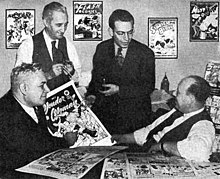Max Gaines
| Max Gaines | |
|---|---|
 | |
| Born | Max Ginzberg September 21, 1894[1] New York City, U.S. |
| Died | August 20, 1947 (aged 52) Lake Placid, New York, U.S. |
| Area(s) | Publisher |
Maxwell Charles Gaines[a] (born Max Ginzberg,[b] September 21, 1894 – August 20, 1947[2]) was an American publisher and a pioneering figure in the creation of the modern comic book.[3][4]
In 1933, Gaines devised the first four-color, saddle-stitched newsprint pamphlet (Funnies on Parade), a precursor to the color-comics format that became the standard for the American comic book industry. He was co-publisher of All-American Publications, a seminal comic-book company that introduced such enduring fictional characters as Green Lantern, Wonder Woman, and Hawkman. He went on to found Educational Comics, producing the series Picture Stories from the Bible. He authored one of the earliest essays on comic books, a 1942 pamphlet titled Narrative Illustration, The Story of the Comics.
After Gaines' death in 1947, Educational Comics was taken over by his son
Early life
Max Ginzberg was born in New York City to a
Career
Gaines had been a teacher, an elementary school principal, a munitions factory worker, and a haberdasher. In 1933 he had begun a new job as a salesperson at
Later in 1933, Gaines collaborated with
All-American Publications
In 1938, Gaines and
Gaines' relationship with Donenfeld and National waxed and waned over the years.[citation needed] By the early 1940s, the All-American titles were branded separately and no longer featured National-owned characters. In 1944, Donenfeld bought out Gaines and merged National and All-American into a single company.[citation needed]
EC Comics
Gaines used the proceeds from the sale of All-American to establish another comics line, Educational Comics.
Death and legacy
On August 20, 1947, at Lake Placid, New York, Gaines, his friend Sam Irwin, and the latter's 8-year-old son William Irwin were aboard a motorboat when it was struck by another boat. Gaines and the elder Irwin died in the accident.[4]
Max Gaines' 25-year-old son, William Gaines, inherited EC and changed the direction of the company.
Although it continued to advertise and sell back issues of the Educational titles, Bill Gaines concentrated on adding new titles to the Entertaining Comics line. He replaced the juvenile humor books with titles pitched to an older audience and strongly influenced by his own love of popular culture. These spanned several genres as he made a transition from romance (Modern Love) and Westerns (Gunslingers) to science fiction (
In 1985, Max Gaines was posthumously named as one of the honorees by DC Comics in the company's 50th anniversary publication Fifty Who Made DC Great.[12]
See also
Notes
References
- ^ U.S. Social Security Applications and Claims Index, 1936-2007; Social Security Administration
- ^ Kaplan, Arie (Fall 2003). "How the Jews Created the Comic Book Industry - Part I: The Golden Age (1933-1955)". Reform Judaism. Vol. 32, no. 1. Archived from the original on March 13, 2016. Retrieved June 11, 2006.
- ISBN 978-0-09-948706-7.
- ^ a b "Two Men Are Killed in Crash of Motorboats on Lake Placid". The New York Times. August 21, 1947. Retrieved March 24, 2016.
Max Charles Gaines, 56 years old...
(subscription required) - ^ "The 13 Most Influential Jewish Creators and Execs, PART 3". September 21, 2015.
- ^ a b c d Jacobs, Frank (1972). The Mad World of William Gaines. Bantam Books. p. 54.
- ^ a b Brown, Mitchell. "The 100 Greatest Comic Books of the 20th Century: Funnies on Parade" (Internet archive link)
- ^ Goulart, Ron. Comic Book Encyclopedia (Harper Entertainment, New York, 2004)
- ^ Hajdu, David (2009). The Ten Cent Plague: The Great Comic-Book Scare and How It Changed America. Picador. p. 21.
- ^ Famous Famous - Carnival of Comics at the Grand Comics Database
- ISBN 0-06-053816-3, p. 144
- ^ Marx, Barry, Cavalieri, Joey and Hill, Thomas (w), Petruccio, Steven (a), Marx, Barry (ed). "M.C. Gaines An Idea Becomes an Industry" Fifty Who Made DC Great, p. 4 (1985). DC Comics.
Further reading
- Coville, James. "The History of Comic Books: Newsstand Period Part 1. 1922–1955". TheComicBooks.com. p. 2. Archived from the original on July 22, 2011.
- Gaines, M. C. "Narrative Illustration: The Story of the Comics." Print, 3 (2). Summer 1942. pp. 25–38.
External links
- "A Moon... A Bat... A Hawk: A Candid Conversation With Sheldon Moldoff". Alter Ego. 3 (4). Spring 2000. Archived from the original on December 1, 2010.
